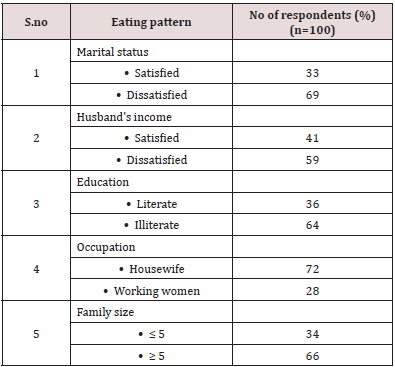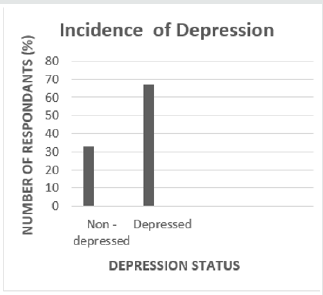
Lupine Publishers Group
Lupine Publishers
Menu
ISSN: 2637-4579
Research Article(ISSN: 2637-4579) 
Determinants of Depression Among Married Women Living in Quetta City, Pakistan Volume 3 - Issue 1
Nida Tabassum Khan*
- Department of Biotechnology, Balochistan University of Informaation Technology, Engineering, and Management Sciences (BUITEMS) Pakistan
Received: November 29, 2018; Published: December 14, 2018
*Corresponding author: Nida Tabassum Khan, Department of Biotechnology, Faculty of Life Sciences and Informatics, Balochistan University of Informaation Technology, Engineering, and Management Sciences (BUITEMS) Pakistan
DOI: 10.32474/OAJBEB.2018.03.000151
abstract
Intense and tenacious feeling of despondency or loss of interest in things that once were enjoyable such condition is termed as Depression which is characterized as a mental illness and contributes a considerable fraction of the inclusive burden of diseases. Determinants of depression among married women includes gender discernment, over burden of work, domestic violence, psychological distress, sexual abuse, women’s poor mental and physical health etc. Identification of potential determinants of depression will possibly aid in devising preemptive strategies in order to reduce its pervasiveness among married women.
Keywords: Depression; Psychological distress; Gender discernment; Cultural bindings; Quetta
Introduction
Depression has been documented as a major mental disorder globally evinced by its fourth position among other diseases [1]. It has been reported that approximately 350 million individuals suffer from it that subsidizes to a high rate of suicide [2]. In Pakistan depression is reported to hold first place among all psychological ailments affecting approximately 29% to 66% women and 10% to 33% of men [3,4]. Depression is intensifying as a major health problem affecting married women with high magnitude than men [5]. Determinants of depression among married women includes gender discernment, over burden of work, domestic violence, psychological distress, sexual abuse, women’s poor mental and physical health etc [6,7]. Besides unforceful life events such as loss of a loved one, subservience, mortification can envisage depression [8]. In addition to that numerous health related issues of married women such as hormonal imbalances, menstrual cycle irregularity, miscarriage, abortion, pregnancy, menopause etc also contributes to high rate of depression [9,10].
A number of married women faces stresses due to over burden of responsibilities both at work and home [11]. Numerous women are also particularly susceptible to postpartum depression after the birth of a baby due to the added responsibility of a new life [12,13]. Married women are reported to be more depressed usually because of her multiple roles as a mother, as a wife, as a daughter-in-law etc and its associated responsibilities [14]. Marital dissatisfaction, family size, occupation, domestic violence, education, cultural setups etc were also reported to be the contributing factors causing depression among married women [15,16]. Quetta city is known for its low countenance, strong customary bindings, cultural reticence, lack of assets and social difficulties [17,18]. Therefore the main purpose of this designed study was to identify the determinants of depression among married women residing in Quetta city and to determine its incidence rate. The reason for choosing married women lies in the fact that married women are more inclined to be depressed that men because they have multiple responsibilities and they are the one who usually faces the ups and downs of life. Consequently, it is important to report this problem to develop mental health sustenance services for women suffering from depression particularly for under developed regional areas.
Materials and Methods
Current study was conducted with the help of a self-developed questionnaire among married women living in different areas of Quetta city, located in the province of Balochistan. The sample size was kept 100.Incidence of depression was measured using 21- item Beck Depression Inventory–II (BDI-II) [19]. The score below 17 indicated non-depressed individuals however score equal to or greater than 17 indicated depressed individuals. Information regarding education, occupation (working status), number of children (family size), husband’s income and marital status was also obtained for the studied respondents.
Results and Discussion
Data in Table 1 shows that a high percentage of married women is facing marital dissatisfaction (69%) which may be due to their husband’s unsatisfactory low earnings as indicated in the mentioned table that 59% of married women were dissatisfied with their husbands’ income causing financial problems. Thus, creating difficulties for such women to support large family. As we all are aware of the concept of combine family system in Pakistan, majority of the households in Quetta has combine family setup which consisted of a large number of dependent individuals relying on a sole independent earning member for their needs [20,21]. Such independent individual is referred as the head of the family and is usually a male. He is responsible for providing the basic necessities of life to his family [22].
And since majority of Pakistani households preferred to have large family size based on their cultural influence and upbringing setups [23]. In such circumstances a low income of the head of the family is not sufficient to support a family of many individuals creating domestic issues which eventually a married woman has to face in the end, leading to mental stress and depression [24,25]. As income is one of the contributing factors of depression, it is well known that women who belongs to low socio-economic group are at elevated risk for depression [26]. Table 1 also indicates that high incidence of depression is mainly due to low literacy rate of married women, only a small percentage of women were literate i.e.36% and a large fraction were reported to be illiterate. According to a study it was reported that educated women were found to be less depressed than low educated or illiterate women because an educated woman is more intellectual and skillful in performing day to day domestic tasks and managing a big household with less mental pressure [27,28]. An educated woman is more fortified with self-sufficiency, decision making capability and confidence [29].
Besides she can also share the financial burden of her husband by doing a job of some kind [30]. Unfortunately working of a female after marriage is not much favored in Pakistani system especially in under developed areas like Quetta due to the narrow mindedness of her male partner or reluctant mentality of her in-laws. Considering the above-mentioned determinants of depression, prevalence rate of this mental disorder was reported to be high i.e.67% among married women as indicted in Table 2 and Graph 1. However, there were several limitations in our study such as information regarding family history of depression, loss of loved ones, current health illness, documentation of domestic violence, sexual abuse, clinical evaluation of women physical/mental health before/after child birth etc which needs to be unveiled in future studies. This study is an endeavor to address the matter of increasing rate of depression among married Pakistani women living in under developed areas to make commendations on how to improve their mental health.
Conclusion
Current study revealed that the overall rate of depression was reported to be high i.e. 67% among married women which is alarming and required clinical diagnosis of depression and its associated treatment. The overall results indicated that depression is high among married women who belongs to a low-income household with large family size. Besides high illiteracy rate is also responsible for depression among married women.
References
- Gelenberg AJ (2010) The prevalence and impact of depression. J Clin Psychiatry 71(3): 6.
- Takahashi Y (2001) Depression and suicide. Japan Medical Association Journal 44(8): 359-363.
- Gadit AAM, Mugford G (2007) Prevalence of depression among households in three capital cities of Pakistan: Need to revise the mental health policy. Plos one 2(2): 209.
- Üstün TB, Ayuso-Mateos JL, Chatterji S, Mathers C, Murray CJ (2004) Global burden of depressive disorders in the year 2000. Br J Psychiatry 184: 386-392.
- Saluja G, Iachan R, Scheidt PC, Overpeck MD, Sun W, et al. (2004) Prevalence of and risk factors for depressive symptoms among young adolescents. Arch Pediatr Adolesc Med 158(8): 760-765.
- Davies L, Avison WR, McAlpine DD (1997) Significant life experiences and depression among single and married mothers. Journal of Marriage and the Family pp. 294-308.
- Kessler RC (2003) Epidemiology of women and depression. Journal of affective disorders 74(1): 5-13.
- Mitchell RE, Cronkite RC, Moos RH (1983) Stress, coping, and depression among married couples. J Abnorm Psychol 92(4): 433-448.
- Fredrickson BL, Roberts TA (1997) Objectification theory: Toward understanding women’s lived experiences and mental health risks. Psychology of women quarterly 21(2): 173-206.
- Weissman MM (1987). Advances in psychiatric epidemiology: rates and risks for major depression. Am Journal Public Health 77(4): 445-451.
- McBride AB (1988) Mental health effects of women’s multiple roles. Image J Nurs Sch 20(1): 41-47.
- Boyce P, Hickey A (2005) Psychosocial risk factors to major depression after childbirth. Soc Psychiatry Psychiatr Epidemiol 40(8): 605-612.
- Najman JM, Andersen MJ, Bor W, O’Callaghan MJ, Williams GM (2000) Postnatal depression–myth and reality: Maternal depression before and after the birth of a child. Soc Psychiatry Psychiatr Epidemiol 35(1): 19- 27.
- Barnett R, Baruch GK (1985) Women’s involvement in multiple roles and psychological distress. J Pers Soc Psychol 49(1): 135-145.
- Coverman S (1989) Role overload, role conflict, and stress: Addressing consequences of multiple role demands. Social forces 67(4): 965-982.
- Simon RW (1995) Gender, multiple roles, role meaning, and mental health. J Health Soc Behav 36(2): 182-194.
- Niaz U (2004) Women’s mental health in Pakistan. World Psychiatry 3(1): 60-62.
- Husain N, Chaudhry N, Jafri F, Tomenson B, Surhand I, et al. (2014) Prevalence and risk factors for psychological distress and functional disability in urban Pakistan. WHO South East Asia J public health 3(2): 144-153.
- Beck AT, Steer RA, Brown GK (1996) Beck depression inventory-II. San Antonio 78(2): 490-498.
- Dale A (2005) Combining family and employment: Evidence from Pakistani and Bangladeshi women. In Work-life balance in the 21st century pp. 230-245.
- Nimkoff MF, Middleton R (1960) Types of family and types of economy. American Journal of Sociology 66(3): 215-225.
- Pullum TW (1983) Correlates of family size desires. Determinants of fertility in developing countries: A summary of knowledge pp. 278-298.
- Ross CE (2017) Social causes of psychological distress. Routledge, United Kingdom, Europe.
- Ettner SL (1996) New evidence on the relationship between income and health. Journal of health economics 15(1): 67-85.
- Belle D (1990) Poverty and women’s mental health. American psychologist 45(3): 385-389.
- Ross CE, Mirowsky J (1989) Explaining the social patterns of depression: Control and problem solving--or support and talking? J Health Soc Behav 30(2): 206-219.
- Ross CE, Mirowsky J, Huber J (1983) Dividing work, sharing work, and in-between: Marriage patterns and depression. Am Sociol Rev 48(6): 809-823.
- Ross CE, Huber J (1985) Hardship and depression. Journal of Health and Social Behavior 26(4): 312-327.
- Hashmi HA, Khurshid M, Hassan I (2007) Marital adjustment, stress and depression among working and non-working married women. Internet Journal of Medical Update 2(1): 19-26.
- Papanek H (1979) Family status production: The” work” and” nonwork” of women. Signs: Journal of Women in Culture and Society 4(4): 775-781.
Editorial Manager:
Email:
biomedicalengineering@lupinepublishers.com

Top Editors
-

Mark E Smith
Bio chemistry
University of Texas Medical Branch, USA -

Lawrence A Presley
Department of Criminal Justice
Liberty University, USA -

Thomas W Miller
Department of Psychiatry
University of Kentucky, USA -

Gjumrakch Aliev
Department of Medicine
Gally International Biomedical Research & Consulting LLC, USA -

Christopher Bryant
Department of Urbanisation and Agricultural
Montreal university, USA -

Robert William Frare
Oral & Maxillofacial Pathology
New York University, USA -

Rudolph Modesto Navari
Gastroenterology and Hepatology
University of Alabama, UK -

Andrew Hague
Department of Medicine
Universities of Bradford, UK -

George Gregory Buttigieg
Maltese College of Obstetrics and Gynaecology, Europe -

Chen-Hsiung Yeh
Oncology
Circulogene Theranostics, England -
.png)
Emilio Bucio-Carrillo
Radiation Chemistry
National University of Mexico, USA -
.jpg)
Casey J Grenier
Analytical Chemistry
Wentworth Institute of Technology, USA -
Hany Atalah
Minimally Invasive Surgery
Mercer University school of Medicine, USA -

Abu-Hussein Muhamad
Pediatric Dentistry
University of Athens , Greece

The annual scholar awards from Lupine Publishers honor a selected number Read More...















